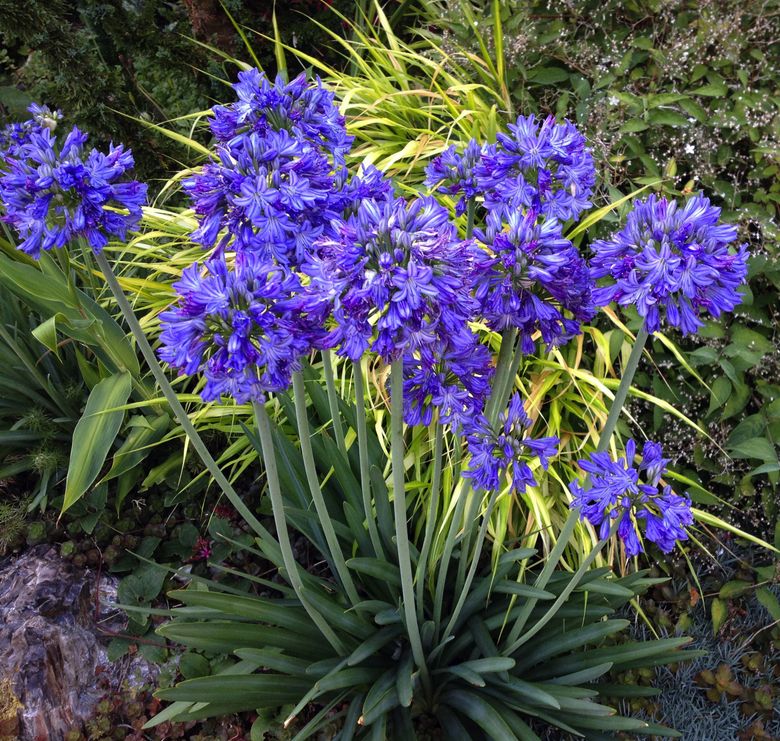Magnificent Agapanthus: Enhancing Your Yard's Appeal
Magnificent Agapanthus: Enhancing Your Yard's Appeal
Blog Article
Unleashing the Secret to Successful Agapanthus Cultivation: Advice for a Flourishing Garden
In the realm of gardening, growing agapanthus efficiently requires a calculated method that encompasses various aspects of plant treatment. By recognizing the nuances of agapanthus cultivation, one can create a setting where these plants thrive and flower perfectly.
Planting Agapanthus: Finest Practices
When growing Agapanthus, proper dirt prep work is important for making certain successful development and advancement of these beautiful flowers. Agapanthus, typically referred to as Lily of the Nile or African lily, flourishes in well-draining soil with a slightly acidic to neutral pH level - Agapanthus. Prior to growing, it is vital to change hefty clay soils with raw material such as garden compost or peat moss to improve water drainage and provide crucial nutrients for the plants
To plant Agapanthus, choose a place that obtains complete sunlight to partial shade, as this will certainly promote healthy and balanced development and abundant flowering. Dig a hole two times the diameter of the plant's origin round and put the Agapanthus at the very same depth it was previously growing. Delicately backfill the opening with soil, pressing down strongly to get rid of any air pockets around the origins.
Water the recently grown Agapanthus extensively and continue to maintain the dirt equally damp, particularly throughout the plant's active growing period. Agapanthus. Using a well balanced plant food once a month can even more sustain the plant's growth and flowering. By complying with these finest methods for growing Agapanthus, you can create a magnificent screen of these exciting blossoms in your garden
Ideal Dirt Issues for Agapanthus
For optimal development and flowering success of Agapanthus plants, guaranteeing the dirt problems are suitable is critical. Agapanthus prefers dirt that is abundant in nutrients, so incorporating a well balanced fertilizer during the expanding period can advertise healthy development and vivid flowers.

Watering and Feeding Tips
To ensure healthy development and dynamic flowers, appropriate watering and fertilizing techniques are important for effective Agapanthus cultivation. Agapanthus plants profit from regular watering, especially during the growing season.
When it comes to feeding Agapanthus, a well balanced fertilizer with equivalent parts nitrogen, phosphorus, and potassium can be applied in the springtime to advertise healthy growth and flowering. Slow-release fertilizers are perfect for supplying nutrients progressively over a prolonged period. Avoid over-fertilizing, as this can bring about extreme vegetation development at the cost of blooms.
In addition, incorporating raw material like garden compost into the dirt can enhance nutrient degrees and boost soil framework, assisting in the general health of visit their website the Agapanthus plants. By complying with these watering and fertilizing ideas, gardeners can guarantee their Agapanthus plants flourish and generate sensational screens of flowers.
Trimming and Deadheading Techniques
Appropriate trimming and deadheading methods play a crucial function in keeping the wellness and aesthetics of Agapanthus plants, enhancing the crucial methods of watering and feeding for effective farming. Pruning Agapanthus includes eliminating spent flower heads, dead or yellowing leaves, and total shaping of the plant to promote much better growth. Deadheading, the process of eliminating discolored flowers, not just enhances the plant's appearance yet also motivates further flowering.
When deadheading Agapanthus, it is suggested to trim off the flower stem at the base utilizing sharp, tidy shears. This procedure reroutes the plant's power from seed production back right into origin and vegetation development, promoting a healthier and extra durable plant. Routine deadheading can expand the blooming duration of Agapanthus and stop self-seeding, which can lead to overcrowding.
In regards to trimming, Agapanthus normally advantages from a light trim after flowering to clean the plant and encourage fresh development. Reducing the invested blossom stems and eliminating any kind of dead or damaged foliage assists keep the plant's vitality and total look. Nevertheless, it is important to avoid reducing into the crown of the plant, as this can deteriorate its health and wellness.

Protecting Agapanthus From Vermins and Diseases
Executing reliable parasite and illness administration techniques is vital to guarding the wellness and vigor of Agapanthus plants in farming. Agapanthus are typically hardy plants, however they can still succumb different pests and conditions if not correctly cared for. One usual insect that affects Agapanthus is the Agapanthus borer, a caterpillar that tunnels into the plant, creating damages to the leaves and blossoms. To prevent invasions, regular inspection of the plants is essential. If borers are discovered, they can be by hand eliminated, or insecticidal soap can be utilized as a control procedure.
In enhancement to pests, he said Agapanthus are prone to diseases such as origin rot and fungal leaf areas. These issues can often be avoided by ensuring appropriate water drainage and preventing overwatering. Impacted components of the plant must be immediately gotten rid of to stop additional spread if indicators of disease appear. Fungicides may also be used as a treatment step, following the producer's guidelines thoroughly. By staying alert and dealing with pest and disease concerns without delay, gardeners can assist their Agapanthus prosper and prosper.

Conclusion
In conclusion, effective cultivation of agapanthus requires appropriate growing methods, optimal dirt conditions, ample watering and feeding, regular pruning and deadheading, and security from diseases and insects. By adhering to these ideas and methods, garden enthusiasts can guarantee a growing yard loaded with lovely agapanthus blooms. Agapanthus. Keep in mind to maintain constant care look at here now and interest to information to promote the health and wellness and longevity of these sensational plants
When planting Agapanthus, appropriate dirt prep work is essential for ensuring effective growth and development of these attractive flowers.Water the recently grown Agapanthus thoroughly and continue to keep the dirt equally wet, especially throughout the plant's energetic growing period.For optimal growth and flowering success of Agapanthus plants, ensuring the soil conditions are excellent is essential. When transplanting or growing Agapanthus, make sure the dirt is well-prepared to supply the needed structure for the plants to establish themselves effectively. One typical bug that impacts Agapanthus is the Agapanthus borer, a caterpillar that tunnels into the plant, causing damages to the fallen leaves and flowers.
Report this page